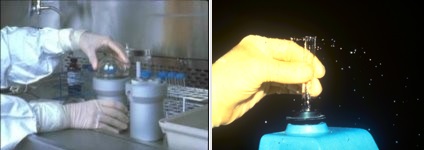Content Status
Type
Linked Node
Biosafety Measures for TB Laboratories: Code of Practice [Laboratory Access, Procedure and PPE]
Learning ObjectivesBiosafety
H5Content
Content
What is a Code of Practice?
A code of practice describes the laboratory practices and procedures essential for implementing good, i.e., safe microbiological techniques.
It includes:
- Laboratory access
- Personal Protective Equipment (PPE)
- Laboratory procedures
Laboratory Access
- International biohazard warning symbols and signs must be displayed on the laboratory door (Figure 1).
- Only authorized persons should be allowed to enter the laboratory’s working areas.
- Children should not be authorized or allowed to enter the laboratory’s working areas.

Figure 1: Lab door with Biohazard Symbol
Practices to Minimize Aerosol Generation in TB Laboratories (Figure 2)
- Use disposable loops or incinerators to sterilize loops.
- Always open and manipulate specimens and cultures in a certified Biosafety Cabinet (BSC).
- Work over absorbent material soaked in disinfectant.
- Use centrifuge safety cups and open them in the BSC.
- Never express all the liquid in the pipette (leave the last bit inside the tip).
- Use caution when disrupting bubbles in tubes of liquid media.

Figure 2: Minimize aerosol production in lab
Personal Protective Equipment (Figure 3)
- Protective clothing: Surgical gowns and lab coats
- Respiratory devices: N95 respirators
- Hand protection: Gloves
- Head protection: Head gears/ hair covers/ caps
- Foot protection: Shoe cover, safety shoes/ closed toe shoes

Figure 3: PPE
Resources
Kindly provide your valuable feedback on the page to the link provided HERE
LMS Page Link
Content Creator
Reviewer
- Log in to post comments